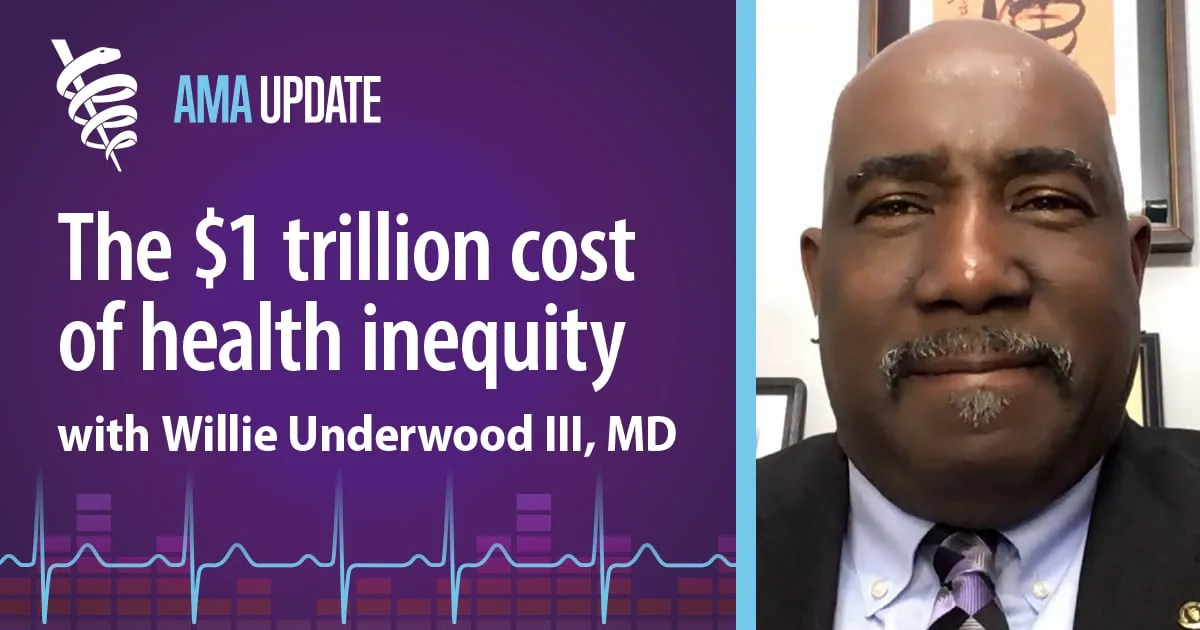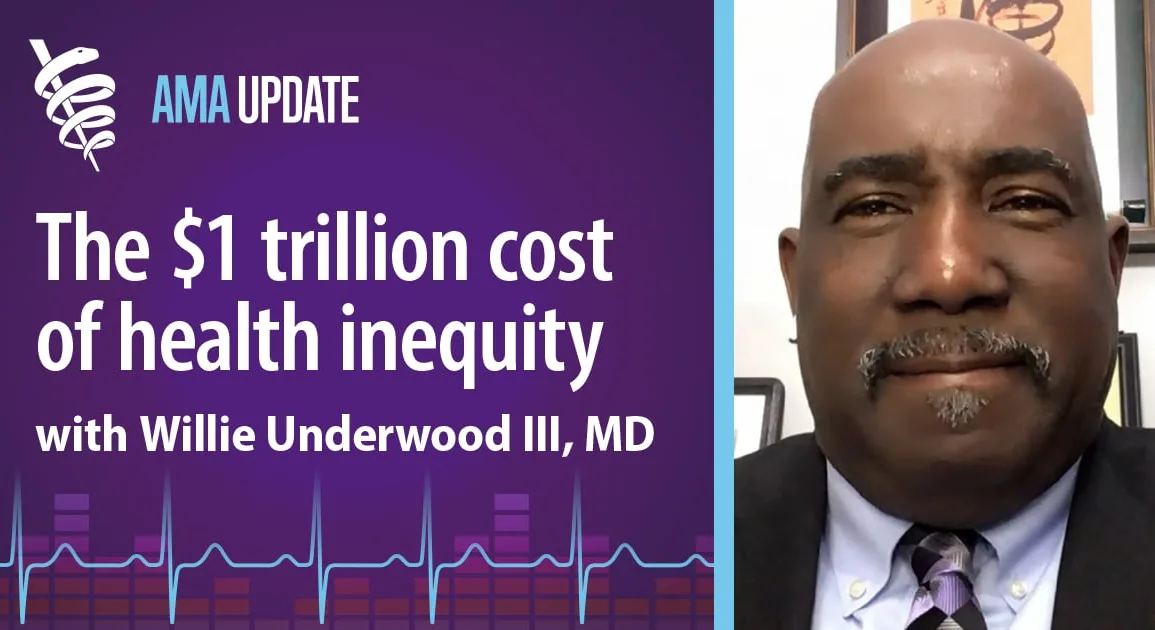
AMA Update covers a range of health care topics affecting the lives of physicians, residents, medical students and patients. From private practice and health system leaders to scientists and public health officials, hear from the experts in medicine on COVID-19, medical education, advocacy issues, burnout, vaccines and more.
Featured topic and speakers
Featured topic and speakers
Health inequity doesn’t just create disparities that impact patient care. It creates an economic burden that impacts all of medicine and the country. Joining to break down the dollars and cents case for why health equity is an urgent priority is Willie Underwood III, MD, MSc, MPH, chair of the AMA Board of Trustees. AMA Chief Experience Officer Todd Unger hosts.
Speaker
- Willie Underwood III, MD, MSc, MPH, chair, AMA Board of Trustees
Transcript
Transcript
Unger: Hello and welcome to the AMA Update video and podcast. Over the years, we’ve talked a lot about health inequity. We’ve discussed the impact that it has on patients, and what physicians and health systems are doing about it. But today, we’re going to focus on the economic impact of health inequity.
And for that, I’m joined by Dr. Willie Underwood, chair of the AMA Board of Trustees. And he’s in Buffalo, New York. I’m Todd Unger, AMA’s chief experience officer in Chicago. Dr. Underwood, thanks so much for joining us today.
Dr. Underwood: Well, thank you for having me. I’m excited about our conversation.
Unger: Well, you recently gave a TEDx Talk on the issue of health inequity. And in it, you presented some alarming figures that underscore the need for action. Why don’t you start by sharing some of those to help put the issue into perspective?
Dr. Underwood: So according to the 2005 study in Health Affairs, that if the Black and white mortality gap were eliminated, an estimated 83,570 excess deaths each year could be prevented. When I looked at the study from 1991 to 2000, that’s 886,202 deaths could have been avoided. When you look at that over a 20-year period, that’s more than 1.7 million deaths of Black people could have been avoided.
Now, when you look at a Pew study in 2022, their research found that 49% of Black adults said that a major reason Black people generally have worse health outcomes is that their health care providers are less likely to give Black people the most advanced medical care. 47% said that hospitals and medical centers giving a lower priority to their well-being is a major reason for diverging or differing health outcomes. Well, we know that, if perceptions are true and 90% of reality, then therefore we, as a health system, as physicians, must do better.
Unger: Those are alarming statistics. And in addition to those, in your talk you also shared some unique statistics about the economic burden of the inequity, which I think is something people don’t consider, they don’t talk a lot about. Will you tell us more about that?
Dr. Underwood: Yes. So when we look at the economic burden, this is just totally unsustainable. In a study in 2009, the economic burden of the health inequalities in the United States, they looked at from 2003 to 2006, and the combined costs of health inequalities and premature deaths was $1.24 trillion.
Unger: Wow.
Dr. Underwood: That is a lot of money. Also from 2003 to 2006, that eliminating health disparities in minoritized people could have reduced direct medical care expenditure by over $229.4 billion. That’s 30% of the direct medical care expenditures for African American, Asians, Hispanics were excess costs due to health inequalities.
Now, that wasn’t enough. In 2002, a study by Deloitte said that the current health inequalities’ direct costs in the United States to the health care system is over $320 billion annually. Now, if left unchecked, that’s going to reach $1 trillion or more by 2040. Our system cannot afford to have an excess cost of $1 trillion.
Unger: That’s interesting to hear you talk about it in terms of that economic impact, when most of the time we talk about the medical impact of health inequity. Do you think, when you frame it as an economic paradigm, that it might inspire more action to address it?
Dr. Underwood: I hope so because what we must understand is that when we talk about health inequities, people look at it, oh, that’s about them. Oh, that’s about a subpopulation. Oh, that’s about some of the American citizens. But also—that’s S-O-M. But this is really about the sum, S-U-M, of Americans’ prosperity, of Americans’ productivity, of our ability to be the great America that we could be, because when the system is burdened by, in this case, currently $320 billion, and looking forward to be $1 trillion, that makes it bad for everyone, for the sum, S-U-M, of our society.
Unger: Well, if you were to lift a burden of that extraordinary extent—we’re talking hundreds of billions of dollars—what would that mean for medicine in this country?
Dr. Underwood: Well, you think about it. So what could we do with $320 billion, right? Number one, we could make a fair, equitable reimbursement for physicians. That’s number one. Number two, we can restructure the system and think about it very differently so that we can assure that every citizen has access to top-quality care.
If we even took that money outside of the health care system, which I hope we wouldn’t, then we can transform our educational system, our other infrastructure issues so that America itself is better off, that all the citizens are better off. We can create economic systems. We can evaluate the social determinants of health and think about how we become more productive as a nation. That’s a lot of money, and we can do a lot of good with it.
Unger: Well, we’ve been talking about kind of macro-level issues in costs, but obviously, working toward a more equitable future for health care is going to require changes at every level. What advice do you have for individual physicians about what they can do in their daily practices?
Dr. Underwood: I tell you, when I think about this, I ask myself that question. And the question I ask, what am I missing? What are my blind spots? What role am I playing in the interaction with this patient that puts them in a position where they don’t come back or they’re considered, quote unquote, “non-compliant?” And how do I address those issues and build greater relationships with everyone that I see?
I would suggest that if I was running a private practice, or even a health system, I would survey the people who are not only are my patients, but the people who were my patients, who I saw, who I interact with briefly, who did not come back or are considered non-compliant, and really get to the bottom of my own personal blind spots or the blind spots of our system to try to figure out where are we contributing to this problem. Most people say I’m not contributing to it, but the data suggests that we all are contributing to it.
Unger: Now, in your TEDx Talk, you also mentioned the role that health systems must play in health equity. What are some of the immediate changes that they can make right now?
Dr. Underwood: Well, so when we think about it, so we need to continue to work together to diversify our profession. Diversity is not only good for our financial portfolio, but it’s also good for our profession and patient care. The scientific literature supports it. We know that the administrative and bureaucratic processes can also exacerbate health disparities. Health systems should continue to examine how they work, how they provide patient care and improve their processes. Even if you’re the best system in the United States, you can be better.
Unger: Well, Dr. Underwood, thank you so much for joining us and for your perspective. And we’re going to make sure to include a link to your TEDx Talk in the description of this episode. Everybody out there, take a look at that. We’ll be back soon with another AMA Update. In the meantime, you can find all our videos and podcasts at ama-assn.org/podcasts. Thanks for joining us today. Please take care.
Dr. Underwood: Thank you for having me.
Disclaimer: The viewpoints expressed in this video are those of the participants and/or do not necessarily reflect the views and policies of the AMA.



